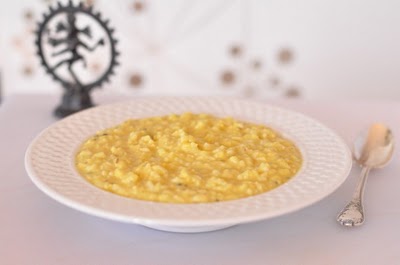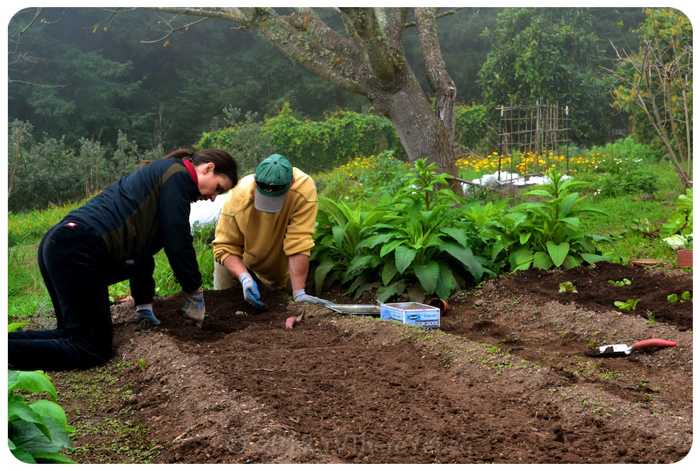Day 3: Ayurvedic Cleanse
So far, it has been pretty easy for me to just eat gentle foods that complement my dosha constitution. Rice, potatoes, vegetables, nuts and seeds, fruit. For the past three days, there have been so many choices without feeling like I’m lacking or doing without. Tomorrow however begins 5 days of pure kitchari consumption. No sugars, no enhancements, no extras. Just specific agni / fire-inducing spices, ghee, white rice and mung dal all cooked up into a lovely porridge mixture known as kitchari. The Kitchari Diet is highly observed as a mono-diet during Panchakarma (Ayurvedic Detox and Rejuvenation). As defined on the Ayurvedic website: ‘MichiMagic‘, Panchakarma literally means “five actions.” Five actions to cleanse, rejuvenate and balance body, mind and consciousness. Ayurveda recommends performing these procedures for each change of season, which is very beneficial for overall health, wellness and self-healing. Although it’s not a change of season right now (Spring is a mere 1 month away!), the timing of the cleanse is impeccable with Shiva Ratri being the ending day of our cleanse and with a support group of 3 others accompanying me along this journey. I love the idea of cleansing, of purification rituals, going to the Ganges, meditation and pranayama, taking a hot bath or sauna — anything detoxifying through a non-energetic means of sweating (cleanses take enough energy as it is). All of these methods have powerful psychological, religious and spiritual meanings. And in turn, a very positive effect on health. Other benefits of a cleanse? Clarity of thought, an invokation of peacefulness and lightness. Also, for many ancient cultures, fasting has helped people “lighten up” after a long winter, shedding any extra winter fat layer that has provided warmth. With us being in California, we really haven’t experienced a hard long cold winter such as I have experienced in the past, coming from Canada. Also, having just taken a course of antibiotics to clear up the remnants of my whooping cough, in addition to my 5 week bout of flu and low energy, a detox of sorts seemed to be a good thing for me to do right now, even thought it’s not a transition of season (when a typical cleanse is done). Spring is only a month away (!!!) and the timing of such an event is austerity at its finest. I’ve done quite a bit of research on different Kitchari recipes. But they all state pretty much the same thing about an Ayurvedic cleanse: the simpler the recipe’s constitution, the better for ones digestion. A mono-diet is defined as a diet that consists of only one type of food. This enables a cleansing effects on the intestinal tract because the mono-diet is easy on ones digestion. A mono meal is very nutritious, and supposedly one can not overeat on a mono meal because ones taste will change to slightly sour when feeling satisfied and full.
 My Proposed Daily Kitchari Recipe (Mungbeans and Rice)
My Proposed Daily Kitchari Recipe (Mungbeans and Rice)
- approx. 5 cups water
- 1 cup split mung beans (aka mung dal), sorted and rinsed well or sprouted whole mung beans
- 1 1/4 cups basmati rice, sorted and rinsed well
- 2″ piece gingerroot, peeled and finely chopped / grated
- 2 teaspoons turmeric
- 2 teaspoons mustard seed
- 1 teaspoon ground or seed cumin (or both!)
- 1 teaspoon ground or seed coriander
- 1/2 teaspoon ground black pepper
- 1/2 teaspoon ground cardamom
- 1/2 teaspoon ground or seed fennel
- pinch of sea salt
- chopped fresh cilantro
- 1/8 teaspoon of asafoetida (this spice is used as a digestive aid, also known as ‘Hing’)
- 2 tablespoons butter or ghee
- Wash the mung dal and rice until water is clear. Soaking the dal for a few hours, overnight or sprouting for a few days helps with digestibility.
- Bring water to boil in a 6-quart soup pot. Add whole sprouted mung beans and cook at a light boil, uncovered. {If using split mung beans, pre-soak the beans for 4-6 hours and skip this first step. Add soaked beans to the ghee mixture with the rice (see step 5).}
- Melt ghee, add turmeric and fry mustard seeds (plus any additional seeds used) until they start popping.
- Add other spices and simmer on medium heat for 2 minutes. Watch and stir so that spices don’t burn.
- Add rice and stir fry for about a minute.
- When beans begin to split open, add rice and spice mixture {skip this step if using split mung beans}.
- Cook 20-25 minutes over medium-high flame, stirring occasionally, and more as it thickens.
- Remove from heat, add fresh cilantro and let it sit another 15 minutes (it will thicken up a little more like a hearty stew).




